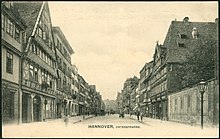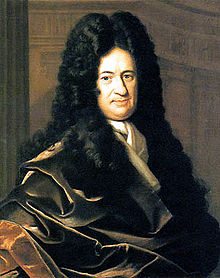Loccumer Hof

The Loccumer Hof in Hanover was a farm yard of the Cistercian monastery of Loccum built in the 13th century . Up until the 20th century, the facility was located on a plot of land between Osterstrasse at the southern end of the high-rise car park and (later) Georgsplatz in the Mitte district .
history
As early as 1279, the Loccum Monastery owned houses in the city of Hanover in the form of two booths on the Hokenmarkte . 1293 a court came in the Osterstraße added, the mainly economic purposes, in particular the sale of own grain - harvest should serve. The monastery expanded this property by purchasing another piece of land from the respected citizen Hans Berhard Haverbecker in Osterstrasse.

Postcard no. 4414 of Zedler & Vogel , 1905
According to the monument conservationist Arnold Nöldeke , the document book [UB] No. 136 documents that the monastery “committed itself in 1320 to build the city wall [as part of the city fortifications of Hanover ] at its court”; The monastery met this obligation by 1337 at the latest. From this fixture has at Georgswall the two listed receive about 4 m high and 80 cm wide walls remaining.
In the monastery courtyard, the monks built a 60- foot- long house, the back of which bordered the guard's passage (for defense along the city wall), while it was further "laid on top of the wall itself". At the same time, the monks built a shelter for other monks visiting the city, which was later used as the abbot's residence.
At other buildings, the Court, among others, soon a bower , a chapel , granary , Surrey - sheds , stables and an open well with a winch , the House of grain writer and taxpayers in - office .
When the monastery Loccum in the 15th century fell into financial difficulties, it had temporarily to the Loccumer Hof in Hanover patrician family of Berkhusen pledge .
1563 stood the abbot and the convent to the city council of the "Closer Sales Convention" to: Without prior knowledge of the Council, the Court could not be sold (to the 20th century).

(portrait of Christoph Bernhard Francke , around 1700; Herzog Anton Ulrich Museum , Braunschweig)
During the Thirty Years' War , the "Loccum Evangelical Conventuals" found refuge on the farm for a while, after the monastery near Loccum had been occupied by a Catholic Cistercian convent for a while as a result of the Edict of Restitution .
Under Abbot Gerhard Wolter Molanus , the Loccumer Hof developed into a meeting place for scholars : Gottfried Wilhelm Leibniz came and went here, Molanus and Leibniz talked about a reunification of denominations with the French bishop Jacques Bénigne Bossuet and the bishop of Wiener Neustadt , Cristóbal de Royas y Spinola .
After the Loccumer Hof had already undergone several structural changes under Abbot Theodor Stracke (1600–1629), the building complex lost its medieval character through extensive changes , especially in the 1730s at the instigation of Abbot Georg Wilhelm Ebell . 1735 sloping ground between the city walls and was Wall - digging transformed into the front yard.
In 1832 the architect Georg Ludwig Friedrich Laves rebuilt the abbot's house on the Loccumer Hof, both inside and out. He adapted the city wall tower from the 15th century on the northeast corner of the abbot's house to the abbot's house with a plaster coating . Finally, the structural changes came to an end with the erection of a wall with a gate passage on Osterstraße.
From 1925 the Loccumer Hof was the official seat of August Marahrens , the regional bishop of the Evangelical Lutheran Church of Hanover .
The Loccumer Hof was destroyed by the air raids on Hanover in World War II.
Hotel Loccumer Hof
In the post-war period , the Evangelical Lutheran Regional Church of Hanover opened the “Hospiz Loccumer Hof” in 1955 on Kurt-Schumacher-Strasse and the corner of Herrenstrasse. The guest house was later operated by the hospice as a hotel, which went into private ownership in 2000 and was redesigned to today's "Hotel Loccumer Hof", supplemented by the neighboring building (formerly "Korb Ritter").
literature
- Arnold Nöldeke : Loccumer Hof. In: Die Kunstdenkmäler der Provinz Hannover Vol. 1, H. 2, Teil 1, Hannover, Selbstverlag der Provinzialverwaltung, Theodor Schulzes Buchhandlung, 1932 (Neudruck Verlag Wenner, Osnabrück 1979, ISBN 3-87898-151-1 ), p. 221 -224
- Waldemar R. Röhrbein : Loccumer Hof. In: Klaus Mlynek, Waldemar R. Röhrbein (eds.) U. a .: City Lexicon Hanover . From the beginning to the present. Schlütersche, Hannover 2009, ISBN 978-3-89993-662-9 , p. 413f.
Web links
- Brief description at hannover.de
- Link to the hotel: http://www.loccumerhof.de
Individual evidence
- ↑ a b c d e f g h i Waldemar R. Röhrbein: Loccumer Hof (see literature)
- ↑ a b c d e f g h i j k Arnold Nöldeke: Loccumer Hof (see literature)
- ↑ Gerd Weiß, Mariann Zehnpfennig: The fortification of the old town In: Monument topography Federal Republic of Germany , architectural monuments in Lower Saxony, City of Hanover, Part 1, [Bd.] 10.1 , ed. by Hans-Herbert Möller, ISBN 3-528-06203-7 , pp. 51f., here: 52; as well as in the middle of : Annex directory of architectural monuments according to § 4 (NDSchG) (excluding architectural monuments of the archaeological monument preservation) , status: July 1, 1985, City of Hanover, Lower Saxony State Administration Office - Institute for Monument Preservation , p. 3ff.
Coordinates: 52 ° 22 ′ 11.3 " N , 9 ° 44 ′ 25.5" E

